Home pregnancy tests are widely used as they are a faster way of knowing whether a woman may be pregnant or not, as many of them promise to work from the first moment of conception, meaning there is no need to wait for the day of a missed period, as is often the case. with pharmacy tests.
However, these types of tests do not have any scientific proof and, therefore, should not be considered a safe way to confirm or rule out a possible pregnancy.
Of all the pregnancy tests that you can do at home, the most reliable is the pregnancy test that you buy at the pharmacy, as it identifies the presence of the beta hormone hCG in a woman’s urine, a type of hormone that is only produced during pregnancy. pregnancy. However, it is also possible to have an hCG blood test, which can be done 8 to 11 days after unprotected intercourse.

8 most used home pregnancy tests
Below we present the most used home pregnancy tests, the theory behind each one and why they don’t work:
1. Online pregnancy test
Online tests are increasingly common, but should only be considered a way of finding out the risk of being pregnant, and should not serve as a definitive test, nor replace a pharmacy or laboratory test.
This is because online tests are based on general pregnancy symptoms, as well as risky activities, and are not able to evaluate each woman individually, nor measure more specific factors, such as the presence of pregnancy hormones in urine or blood.
This is an example of an online test that we created with the aim of evaluating a woman’s chances of being pregnant, indicating when there is a greater need to take a pregnancy test, such as a pharmacy test or a blood test:
2. Salt test
According to this popular theory, this test should be done by adding urine with a few spoons of table salt in a transparent container. Afterwards, you must wait a few hours and, if the mixture does not change its appearance, the result is negative. If the mixture has a milky appearance, the result is positive.
This result would happen due to a reaction between the beta hormone hCG and salt. However, there is no study that proves this reaction between table salt and beta hCG.
3. Do saliva tests
The saliva test to identify pregnancy is also a popular test that consists of using a microscope, which can be a toy, and a slide, which comes with the device. A little saliva should be placed on the slide, allowing it to dry completely and evaluating the material under a microscope.
If the saliva forms crystals similar to fern leaves, it means that the woman is in her fertile period and, therefore, is not pregnant. If crystals without a specific shape appear, it means that the woman is not in her fertile period and may be pregnant.
This is explained because women have high levels of the hormone estrogen in the body during ovulation, which influences the crystallization of saliva.
However, this method is not considered a reliable form of pregnancy testing because a woman may have high estrogen levels in other cases as well, such as an ovarian tumor, obesity, or superfetation, which is a condition in which a woman ovulates during pregnancy. pregnancy. Understand better what superfetation is.
4. Bleach test
According to popular theories, this test works because bleach is capable of reacting with the beta hormone HCG, just like what happens in the pharmacy test, leading to foam formation. Therefore, if there is no foam formation, the test is considered negative.
However, there is no study that confirms this effect. Furthermore, the reaction of urine with bleach can lead to foam formation in men as well.
5. Vinegar test
This test was created around the concept that the pH of a pregnant woman’s urine is generally more basic than that of a non-pregnant woman. Thus, the idea is that when vinegar, which is more acidic, comes into contact with urine, it causes a reaction that leads to a change in color, indicating a positive result for pregnancy.
However, vinegar does not always change color when in contact with a more basic substance. Furthermore, despite being more basic, the pH of a woman’s urine remains acidic, which would prevent the reaction.
6. Swab Test
The swab test is an unsafe method in which the woman must rub the tip of a swab in the vaginal canal, close to the cervix, to identify whether there is the presence of blood.
This test must be done a few days before the expected date of menstruation and serves to identify whether the period is coming down. Therefore, if the swab becomes covered in blood, it may indicate that the woman is not pregnant because her period is approaching.
Although this appears to be a reliable method, it is not recommended. Firstly, because the friction of the cotton swab on the walls of the vagina can cause injuries that can bleed and affect the results. Furthermore, using a cotton swab inside the vaginal canal, and close to the cervix, can facilitate the entry of bacteria, causing an infection.
7. Boiled urine test
The boiled urine test appears to be based on the theory that boiling proteins, as in the case of milk, causes foam to form. As the beta hormone HCG is a type of protein, if the woman is pregnant, an increase in this protein in the urine could cause foam to form, generating a positive result.
However, there are other conditions that can also increase the presence of proteins in the urine, such as urinary tract infections or kidney diseases. In these cases, the test could also have a positive result, even if the woman was not pregnant.
Furthermore, if there are traces of cleaning products in the pan where the pee would be boiled, foam could also be formed due to chemical reactions with the product, resulting in a false positive.
8. Needle test
In this home test, it is necessary to place a needle in a urine sample for a few hours and then observe whether there is any change in the color of the needle. If the needle has changed color, it means the woman is pregnant.
The theory behind this test is that of metal oxidation, which happens when a metal, such as a needle, is in prolonged contact with another substance, such as water or, in this case, urine, ending up rusting. However, this is a process that usually takes several days and does not happen in a few hours.
Furthermore, the rate of oxidation varies according to factors other than just contact with urine, such as environmental temperature, needle wear or exposure to sunlight, for example, which are not taken into account in this home pregnancy test. .
What is the best pregnancy test?
Of all the pregnancy tests that you can do at home, the most reliable is the pregnancy test that you buy at the pharmacy, as it measures the presence of the hormone beta HCG in the woman’s urine, a hormone that is only produced in cases of pregnancy. .
But despite being a reliable test, the pharmacy test may not detect pregnancy when it is performed too early or when it is done incorrectly. The ideal time to take the pharmacy pregnancy test is when your period is 7 days or more late. However, it can already give a positive result from the 1st day of a missed period. See how to take the pharmacy pregnancy test and get a correct result.
To find out if they are pregnant before a missed period, women can take a blood test that identifies the amount of the HCG hormone and can be done 8 to 11 days after intercourse. Understand better how this blood test works and when to take it.

Sign up for our newsletter and stay up to date with exclusive news
that can transform your routine!
Warning: Undefined array key "title" in /home/storelat/public_html/wp-content/plugins/link-whisper-premium/templates/frontend/related-posts.php on line 12
Warning: Undefined array key "title_tag" in /home/storelat/public_html/wp-content/plugins/link-whisper-premium/templates/frontend/related-posts.php on line 13



